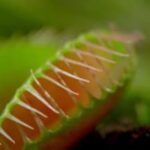As an Amazon Associate, this site earns commissions from qualifying purchases. For more details, click here.
Because pitcher plants are not like your typical plant, raising them necessitates a different approach. This is very important because you must be able to determine if the plant is dying and what steps you can take to save it.
Pitcher plants can die from lack of water, insufficient light or low humidity. Symptoms include brownish, deformed leaves, mushy roots and new pitchers no longer grow. Too much heat and infections can also be fatal to these plants.
Signs of a Dying Pitcher Plant
The first thing you have to do is not panic. Some pitcher plants seem like they are dying but are actually going through its normal life cycle.
For instance, leaves on dormant pitcher plants turn brown. They stop making new pitchers and refuse to eat bugs. The plant withers and shrinks to the point it looks dead. However it is merely going through dormancy and will grow again when winter ends. You do not need to cure or save these plants as this is normal.
Pitcher plants also suffer from stress when there is a change in their environment. If you just bought a nepenthes and placed it inside your house, the plant will need time to adjust. The temperature, humidity, light, water, food availability etc. have all changed. Give the plant a few days or a couple of weeks to adjust and it will start eating again.
It is normal for these plants to discard some leaves or temporarily refuse to eat. In due time the plant will acclimatize to its new surroundings.
If your plant is not dormant and has been in the same location for a long time, these symptoms should not appear. If they do, it is a sign your pitcher plant is dying. Below are the reasons and solutions.
Leaves are Dry and Crispy
Pitcher plants thrive in humid places and you can tell by their appearance. Dried, crispy leaves are fragile and feel hot to touch. They are very rough and usually brown, yellow or black.
If you look inside the pitcher, you will see that it is dry too. Pitchers must have water and other liquids to digest bacteria. A dried out pitcher is also inhospitable for bacteria that help digest insects.
Solution: water often, add humidity to its environment and reduce direct sunlight exposure. The humidity should be at least 50%, higher if the plant is very weak.
Move the plant indoors or anywhere far from direct light, but partial light is still required. Nepenthes should be kept between 65-85 F, while sarracenia can hold up well up to 90 F.
Water the plant so the soil is always moist. We suggest Poland Spring Water because it is fresh and natural, exactly what these plants need.
Cut off the dehydrated, dead leaves. Keep the plant in this moist, humid area. As long as the soil is moist and there is 6-8 hours of partial light, the plant will recover. If the rhizome is not damaged, expect new leaves to come out after some time.
Yellow and Rotting Leaves
As leaves get older, they turn yellow and brown before falling off. These will be replaced by new growth. So if your pitchers turn yellow and brown during winter, it is normal. But if the pitchers fall off and are not replaced by new ones, there is a growth problem.
Insects provide nutrition and well fed pitcher plants grow faster and live longer. Whether the plant eats once a month or once a week, they will always need pitchers for nutrition.
Solution: over watering and lack of light are the common reasons. Nepenthes in particular does not grow well in waterlogged situations. The soil should be moist but not soggy, and too much water damages the roots and leaves.
The solution is to reduce watering and provide more light. If the plant is indoors, bring it outside and expose to direct sunlight. Pitcher plants need at least 6-8 hours of light.
It is ls possible that too much light is causing the leaves to turn yellow. If you notice yellowing during summer, provide partial shade for the plant. For example, move the plant to a shaded location at high noon when the sun intensity is at its peak. If you are growing nepenthes indoors,, use quality lighting such as AeroGarden Harvest Elite Grow Lights.
Deformed Leaves
Deformed, half eaten leaves are signs of bug infestation. While pitcher plants eat insects, they can be infested by spider mites, aphids and other bugs. Spider mites deprive plants of chlorophyll and if left untreated, cause serious damage.
Solution: if there are only a few bugs, you can pick them off one by one. Spraying with water is usually enough to get rid of most pests. Use an insecticide as a last resort or if the infestation is severe. Once the bugs are gone, observe the plant closely and see how it recovers.
No New Pitchers Grow
Pitchers turn brown or yellow when they get old. Then they wither just like regular leaves. During the growth period, new pitchers will grow in their stead. If pitchers wither in the fall and are not replaced, that is normal as your plant is preparing for dormancy. Even nepenthes, which does not go dormant, may slow down during the cold season.
In these cases there is nothing to be concerned about. But you have to take action if old, dying pitchers are not replaced during spring and summer. If the remaining pitchers also close down that will create more problems.
Solution: look inside any remaining pitchers and check if there is liquid inside. If there is none, the plant needs more water and humidity. Increase watering frequency, but be careful not to drench the soil.
Are there any insects in the pitchers? If the plant is outdoors there should be a few of them. If there is none, your plant is no longer eating. Examine the rest of the leaves for signs of infestation, infection, overheating or lack of water.
Keep the plant in a high humidity location. Move the plant indoors if the temperature goes over 100 F. If it is already indoors, increase air circulation. Adjust its exposure to sunlight, increasing and decreasing depending on how the leaves respond.
Leaves Turn Brown
It is acceptable for pitchers to turn brown or yellow as time goes by. It is part of the life cycle for all plants. But what if you notice that the plant is not producing any more leaves? If your pitcher plant does not undergo dormancy and it is not yet fall, try the following.
Solution: water from the top so the soil is moist. Repeat as soon as the soil starts to dry. Use purified or distilled water.
Do not use tap water as it contains elements that are fatal to many pitcher plants. High amounts of chloride combined with cold water can hinder growth.
Just like with yellowed leaves, too much sunlight can be harmful. The leaves will dry out and lose its moisture. The simplest solution is to add more moisture and humidity to the environment. Remember to balance the need for sunlight – too much or too little will damage the leaves – so keep an eye out on how the plant responds.
Pitcher Plant Turns Black
If the entire plant has turned black, it is a sign of a serious ailment. It is likely a fungal or bacterial infection that has already spread. The best option is to cut off all the blackened leaves and pitchers.
Solution: provide 8 hours of light every day and boost the humidity. Water the plant and try to feed the remaining pitchers. If you smell something bad in the plant, root rot might be spreading. In his case you have to repot the plant.
While you are it, examine the roots and prune any mushy parts. Leave only the robust roots and plant in a new container with nutrition free soil.
Conclusion
If you are new to pitcher plants, knowledge is the key. As long as you raise the plant in the proper environment it should be fine. And in the event that the symptoms above appear, at least you know the causes and what solutions are available.

My fascination with carnivorous plants began many, many years ago with Venus Fly Traps. Now I am more than happy to impart what I know with other enthusiasts and those who are curious about meat eating plants.



